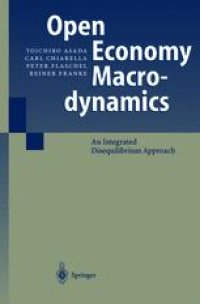
Ebook: Open Economy Macrodynamics: An Integrated Disequilibrium Approach
- Tags: Macroeconomics/Monetary Economics, Economic Theory, Game Theory Economics Social and Behav. Sciences
- Year: 2003
- Publisher: Springer-Verlag Berlin Heidelberg
- Edition: 1
- Language: English
- pdf
In the first part of this book, we treat interacting and small open economies. We do this from an historical perspective, starting from the Classical model of the gold standard and the specie-flow mechanism and aim to show there that the Dornbusch IS-LM-PC approach, with or without rational expectations, can still be considered as a (if not the) core contribution to contemporaneous open economy macrodynamics, also on the level of structural macroeconometric model building. In the second part we then extend this analysis to the incorporation of more disequilibrium on the real markets, prominent further feedback channels of the macrodynamic literature and integrated macromodel building. We start from the closed economy, consider large open economies in a fixed exchange rate system, small open economies subject to high capital mobility, and finally two large interacting economies like the USA and Euroland. Our macrofounded approach extends and integrates non-market clearing traditions to macrodynamics and can be usefully compared with the New Keynesian approaches which are generally rigorously microfounded, but often much more limited in scope in capturing full market and agent interactions.
In the first part of this book, we treat interacting and small open economies. We do this from an historical perspective, starting from the Classical model of the gold standard and the specie-flow mechanism and aim to show there that the Dornbusch IS-LM-PC approach, with or without rational expectations, can still be considered as a (if not the) core contribution to contemporaneous open economy macrodynamics, also on the level of structural macroeconometric model building. In the second part we then extend this analysis to the incorporation of more disequilibrium on the real markets, prominent further feedback channels of the macrodynamic literature and integrated macromodel building. We start from the closed economy, consider large open economies in a fixed exchange rate system, small open economies subject to high capital mobility, and finally two large interacting economies like the USA and Euroland. Our macrofounded approach extends and integrates non-market clearing traditions to macrodynamics and can be usefully compared with the New Keynesian approaches which are generally rigorously microfounded, but often much more limited in scope in capturing full market and agent interactions.
In the first part of this book, we treat interacting and small open economies. We do this from an historical perspective, starting from the Classical model of the gold standard and the specie-flow mechanism and aim to show there that the Dornbusch IS-LM-PC approach, with or without rational expectations, can still be considered as a (if not the) core contribution to contemporaneous open economy macrodynamics, also on the level of structural macroeconometric model building. In the second part we then extend this analysis to the incorporation of more disequilibrium on the real markets, prominent further feedback channels of the macrodynamic literature and integrated macromodel building. We start from the closed economy, consider large open economies in a fixed exchange rate system, small open economies subject to high capital mobility, and finally two large interacting economies like the USA and Euroland. Our macrofounded approach extends and integrates non-market clearing traditions to macrodynamics and can be usefully compared with the New Keynesian approaches which are generally rigorously microfounded, but often much more limited in scope in capturing full market and agent interactions.
Content:
Front Matter....Pages I-XVII
The Closed Economy: The Frisch or Keynes Paradigm?....Pages 1-31
Front Matter....Pages 33-37
Classical Two-Country Dynamics: Pure Price Adjustments?....Pages 39-89
Keynesian Two-Country Dynamics: Pure Quantity Adjustments....Pages 91-124
Output, Interest and Changing Exchange Rate Regimes....Pages 125-167
Exchange Rate Volatility....Pages 169-243
Front Matter....Pages 245-249
KMG Model Building: The Baseline Case of a ‘Closed’ US-Economy....Pages 251-294
Large Open KMG Economies: Germany within the EMU....Pages 295-329
Small Open KMG Economies: Australia and the Murphy model....Pages 331-401
Global Stability: Subsystem Approaches....Pages 403-449
Two-Country Business Cycle Models: ‘Euroland and the USA’....Pages 451-516
Back Matter....Pages 517-540
In the first part of this book, we treat interacting and small open economies. We do this from an historical perspective, starting from the Classical model of the gold standard and the specie-flow mechanism and aim to show there that the Dornbusch IS-LM-PC approach, with or without rational expectations, can still be considered as a (if not the) core contribution to contemporaneous open economy macrodynamics, also on the level of structural macroeconometric model building. In the second part we then extend this analysis to the incorporation of more disequilibrium on the real markets, prominent further feedback channels of the macrodynamic literature and integrated macromodel building. We start from the closed economy, consider large open economies in a fixed exchange rate system, small open economies subject to high capital mobility, and finally two large interacting economies like the USA and Euroland. Our macrofounded approach extends and integrates non-market clearing traditions to macrodynamics and can be usefully compared with the New Keynesian approaches which are generally rigorously microfounded, but often much more limited in scope in capturing full market and agent interactions.
Content:
Front Matter....Pages I-XVII
The Closed Economy: The Frisch or Keynes Paradigm?....Pages 1-31
Front Matter....Pages 33-37
Classical Two-Country Dynamics: Pure Price Adjustments?....Pages 39-89
Keynesian Two-Country Dynamics: Pure Quantity Adjustments....Pages 91-124
Output, Interest and Changing Exchange Rate Regimes....Pages 125-167
Exchange Rate Volatility....Pages 169-243
Front Matter....Pages 245-249
KMG Model Building: The Baseline Case of a ‘Closed’ US-Economy....Pages 251-294
Large Open KMG Economies: Germany within the EMU....Pages 295-329
Small Open KMG Economies: Australia and the Murphy model....Pages 331-401
Global Stability: Subsystem Approaches....Pages 403-449
Two-Country Business Cycle Models: ‘Euroland and the USA’....Pages 451-516
Back Matter....Pages 517-540
....